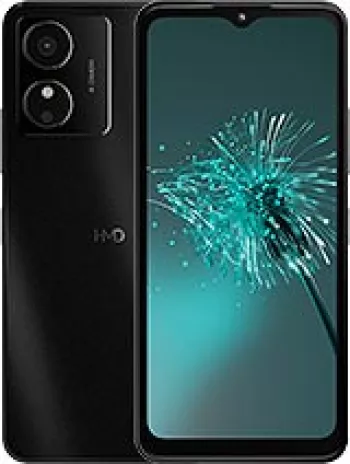
Overview of HMD Key
The HMD Key, announced in January 2025 and released the following February, has positioned itself as an affordable yet functional option in the smartphone market. Its combination of decent specs, a user-friendly Android 14 OS, and a competitive price point make it a viable choice for first-time smartphone users or those seeking a secondary device.
Design and Display
The HMD Key's design dimensions are 166.4 x 76.9 x 9 mm, and it weighs 185.4 grams, creating a manageable form factor that feels substantial yet easy to handle. The phone features a 6.52-inch IPS LCD display with a resolution of 576 x 1280 pixels and a peak brightness of 460 nits. The screen's 20:9 aspect ratio and ~80.2% screen-to-body ratio offer a decent viewing experience for media consumption and browsing, although it's not particularly vibrant or high-definition.
Performance and Hardware
Powering the HMD Key is the Unisoc SC9832E chipset, which, although not top-of-the-line, provides adequate performance for everyday tasks. The quad-core Cortex-A53 CPU running at 1.3 GHz, coupled with the Mali-820MP1 GPU, is designed to handle basic applications and multitasking without significant lag. However, users might notice performance bottlenecks when running more demanding apps or games.
The phone is fitted with 2GB of RAM and 32GB of internal storage, expandable via a microSDXC card that uses a shared SIM slot. This storage configuration is standard for entry-level devices, offering enough space for essential apps and media files.
Operating System
The HMD Key runs on Android 14 (Go edition), a lightweight version of Android designed for devices with lower memory and processing power. This OS optimizes the user experience by utilizing less memory and storage while maintaining access to Google's full suite of apps, albeit simplified versions.
Camera Capabilities
The device features a single rear camera with an 8 MP sensor, supported by autofocus, LED flash, and panorama capabilities. Though not designed for professional photography, the camera is sufficient for casual photography and quick snapshots. The front-facing 5 MP camera is quite basic but functional for video calls and selfies.
Battery Life
The HMD Key is powered by a 4000 mAh battery, a robust capacity for a device in its class, assuring users of prolonged use without frequent charging. The battery supports 10W wired charging, providing convenience through the USB Type-C port. The longevity of the battery is a strong selling point, especially for users who prioritize battery endurance over high performance.
Connectivity and Additional Features
Connectivity options for the HMD Key include GSM, HSPA, and LTE networks, with a range of supported 2G, 3G, and 4G bands. It features standard wireless connectivity options such as Wi-Fi 802.11 b/g/n and Bluetooth 4.2 with A2DP and LE support. Location services are supported by GPS and GALILEO.
The phone includes an FM radio and retains the 3.5mm headphone jack, catering to traditional users who value wired audio options. However, it lacks NFC functionality, which could be a disadvantage for those accustomed to contactless payment methods.
Sensors integrated into the device comprise an accelerometer and a proximity sensor, providing basic interactive features of mobile usage.
Conclusion
Overall, the HMD Key offers a balanced package for its price point, approximately 70 EUR. With a focus on affordability, longevity, and utility, it caters well to budget-conscious consumers or those entering the smartphone market for the first time. It may not satisfy users seeking high-end performance or complex features, but it asserts itself as a dependable and straightforward option for everyday use.
Main Features of HMD Key
- Supports GSM, HSPA, and LTE technologies
- Compact design with dimensions of 166.4 x 76.9 x 9 mm and weight of 185.4 g
- 6.52-inch IPS LCD display with 460 nits peak brightness
- Powered by Android 14 (Go edition) operating system
- Equipped with Unisoc SC9832E chipset and quad-core processor
- Expandable storage via microSDXC card slot
- 8 MP wide main camera with autofocus and LED flash
- 5 MP selfie camera
- Includes a 3.5mm headphone jack and FM radio
- 4000 mAh battery with 10W wired charging
- Available in Black and Blue colors at an affordable price of about 70 EUR
HMD Key Device Disadvantages
- Low display resolution of 576 x 1280 pixels, resulting in ~215 ppi density.
- Limited processing power with a Quad-core 1.3 GHz Cortex-A53 CPU and a Unisoc SC9832E chipset.
- Minimal RAM of only 2GB, which may affect multitasking performance.
- Low internal storage capacity of 32GB, potentially requiring frequent microSD card usage for expansion.
- Basic camera setup with an 8 MP main camera and 5 MP selfie camera, potentially delivering average image quality.
- No NFC support, limiting the ability to use mobile payment apps or quick data sharing functionalities.
- Basic Bluetooth version 4.2, missing out on improved features and energy efficiency of newer versions.
- Limited display brightness with a peak of 460 nits, which may affect visibility in bright conditions.
- Charging speed limited to 10W, leading to longer charging times for the 4000 mAh battery.


View Also
More Phones
All Rights Reserved +14069 Phones © Mobilawy 2025
























